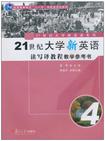21世纪大学新英语读写译教程教学参考书
2010-9
复旦大学出版社
李战子 编
378
2007年出版的《大学英语课程教学要求》(以下简称《课程要求》)是指导我国大学英语教学的一个纲领性文件。《课程要求》对大学英语教学的定位是:“大学英语是以外语教学理论为指导,以英语语言知识与应用技能、跨文化交际和学习策略为主要内容,并集多种教学模式和教学手段为一体的教学体系”。大学英语的教学目标是“培养学生的英语综合应用能力,……同时增强其自主学习能力,提高综合文化素养,以适应我国社会发展和国际交流的需要”。 鉴于我国幅员辽阔,地区与地区之间、高校与高校之间客观上存在较大差异,《课程要求》提出了“分类指导、因材施教”的原则。其具体体现为大学英语教学分为三个层次:一般要求、较高要求和更高要求。其中的一般要求为高等学校非英语专业本科毕业生应达到的基本要求;较高要求或更高要求适用于对办学定位、类型和人才培养目标定位较高的学校。 《课程要求》提出构建大学英语课程体系。该课程体系既包括必修课程和选修课程,也涵盖不同课程类别:综合英语类、语言技能类、英语应用类、语言文化类和专业英语类。 《课程要求》提出一种综合教学模式,即采用基于计算机和课堂的英语教学模式;在充分利用现代信息技术的同时,继承和发扬传统课堂教学的优势。 《21世纪大学新英语读写译》系列教材力求体现《课程要求》的原则和精神,在编写宗旨、单元设计、材料选择、课堂活动和课堂练习的设计上力图忠实地诠释《课程要求》的各项指标。本系列教材为综合英语类的必修课程教材。 一、编写总则 本系列教材以《大学英语课程教学要求》为准则,以先进的外语教学理论为指导。教材的总体设计体现“以人为本”的人文主义教育观,注重培养学生的人文素质。教材编写坚持做到“四个结合”:语言知识与语言技能相结合、单项技能与综合应用能力相结合、语言教学与文化传授相结合、课堂教学与自主学习相结合。教材编写注重对学生的“多维度”“一体化”培养:即语言能力、学习策略、文化素养的同步培养。在教学模式上本系列教材着重构建多层次、立体化教学模式。 二、选材要求 在编写过程中我们力图使内容具有时代性、趣味性、可思性和人文性;既要反映时代潮流,又要具有思想深度和弘扬积极的人生态度。语言难度适中,同时具有可教性。体裁和题材要体现多样性。
《普通高等教育“十一五”国家级规划教材·21世纪大学新英语系列:21世纪大学新英语读写译教程教学参考书(4)》力求体现《课程要求》的原则和精神,在编写宗旨、单元设计、材料选择、课堂活动和课堂练习的设计上力图忠实地诠释《课程要求》的各项指标。本系列教材为综合英语类的必修课程教材。
邹申,上海外国语大学英语学院教授、博士、博士生导师。教育部高等学校外语专业教学指导委员会委员、英语专业教学分指导委员会副主任委员,享受国务院政府特殊津贴。近年来主要从事外语教学法及语言测试研究,曾主持1993年、1996版及2004版高校英语专业四、八级考试大纲的修订工作。目前负责英语专业四、八级考试的相关研究及工作。已发表相关论文数十篇,主要有:《考试评估中的信息反馈》、《TEM8写作能力评估——要求、问题及对策》、《试论口语测试的真实性》;主编的教材有:《简明英语测试教程》、《语言测试》(研究生教材)、《英语写作》(本科生系列教材),其中《简明英语测试教程》获2002年教育部全国普通高校优秀教材一等奖;《英语写作》系列教材获2009年上海市高等教育教学成果二等奖。 李战子,南京解放军国际关系学院二系主任,教授、博士、博士生导师。自1999年起连年获国际关系学院优秀教员、优秀教学工作一等奖、科研先进个人等称号。2001年获全军院校育才金奖;2003年获总参优秀中青年专家称号;2005年、2006年获国际关系学院专业技术重大贡献奖;2007年被评为全军优秀教师;2001年参加“军事外交英语专业课程体系建设”获军队教学一等奖暨国家教学二等奖(合作,五人中排名第二);2009年3月《新型军事外交学科专业体系建设》项目获院教学成果三等奖(五人中排名第一)。 近几年出版的著作有:《语言学简明教程》(第二主编)、《语言学教程》(参编)、《语言学高级教程》(参编)、《系统功能语言学概论》(参编)。
Unit 1 College EducationTeaching ObjectivesLead-inReading Focus-Text AThe Disadvantages of an Elite EducationIntegrated ExercisesReading Focus-Text BEducation Is Supposed to Make You Rich, Not WealthyIntranet AssignmentsUnit 2 Science or SuperstitionTeaching ObjectivesLead-inReading Focus-Text AUFO: an Undeniably Fading ObsessionIntegrated ExercisesReading Focus- Text BA Few Kind Words for SuperstitionIntranet AssignmentsUnit 3 Old and YoungTeaching ObjectivesLead-inReading Focus-Text AOld Before Her TimeIntegrated ExercisesReading Focus-Text BA Return to RootsIntranet AssignmentsUnit 4 Sports and HealthTeaching ObjectivesLead-inReading Focus-Text ATime to Get MovingIntegrated ExercisesReading Focus-Text BGet a Killer Bod with Killer BeesIntranet AssignmentsUnit 5 HappinessTeaching ObjectivesLead-inReading Focus-Text AThe Long and Short of ItIntegrated ExercisesReading Focus-Text BHappiness: A Buyer's GuideIntranet AssignmentsUnit 6 EcologyTeaching ObjectivesLead-inReading Focus-Text AThe Biology of Global WarmingIntegrated ExercisesReading Focus —— Text BEarth Meanders: Resisting Global Ecological ChangeIntranet AssignmentsUnit 7 Technology and ProgressTeaching ObjectivesLead-inReading Focus-Text AIs Anyone Out There Listening?Integrated ExercisesReading Focus-Text BWhy E-mail Has Become the New Snail MailIntranet AssignmentsUnit 8 Humanity and NatureTeaching ObjectivesLead-inReading Focus-Text AA Long, Melancholy Roar-Are Modern Human FearsMisplaced?Integrated ExercisesReading Focus-Text BEye of the TigerIntranet Assignments
Nothing prepared Lily Honegger for what she saw on her first Red Sea dive in 1972. A scubanovice, she had braved only the chilly, relatively lifeless Mediterranean. But off the coast of Sudan,she discovered a community of coral and manta rays, reef sharks and tropical fish. She marveled atnature's palette, with its startling yellows, brown-tinged reds and bold blues. Then a fashion buyer,Honegger thought:"Someone should make a collection out of this." A collection, it turns out, and a career. Photographic film has since become Honegger's fabric, thesea her muse. She and her husband Otto have created a pictorial record of the creatures found in andaround coral reefs. The Swiss couple's images capture elements of marine life even more colorful thanthose they first saw in the Red Sea. The Honeggers make three or four diving trips annually. First, they pick a destination. They go tothe Maldives at least once a year and also dive frequently in Indonesia. Next comes research: whatcreatures can we expect to find, at what depth and on which reef? Then there are the logistics, frompreparing their two underwater cameras and packing the dozens of rolls of film needed on a three-weektrip to arranging boats to take them out to sea. The two view the underwater world from different perspectives. Take the blue giant clam. LilyHonegger, her eye trained by the fashion world to look for patterns and hues, sees robust swirls andstripes of blue and black. "The combination of colors is unbelievable," she says. "This is abstract art,and a painter couldn't do better." Otto Honegger examines, with his scientist's lens, a living, breathingsample of Tridacna maxima, one of the more common giant clams, with a range from East Africa toPolynesia. As a youth, he had wanted to become a scientist. For family reasons, he studied businessinstead. Now a television producer, Otto finds marine photography a way of returning to his first love,biology. ……
